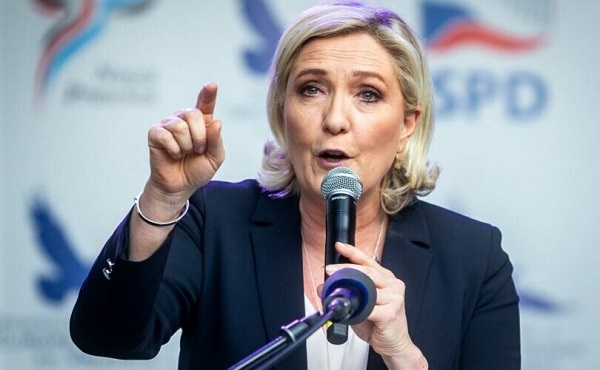Opinion
Globalist elites around the world are trying to ‘protect democracy’ by eliminating right leaning competition

Marine Le Pen of the National Rally Party in France has been completely vilified by the establishment
From LifeSiteNews
By Emily Finley
The classic definition of democracy is ‘rule by the people’. The elites have a new definition of ‘democracy,’ denoting democracy as hypothetical ideal.
Many are calling the present political turmoil in Europe a crisis of democracy. The German establishment is trying to ban the right-wing AfD Party for its alleged desire to return Germany to fascism. In France, the progressives are doing their darndest to hamstring conservative Marine Le Pen and her National Rally Party after they won the first round of the French elections. And in Romania, the Constitutional Court just nullified the results of a presidential election because the “right wing” victor ostensibly benefited from Russian “election interference.”
But which definition of “democracy” are we talking about? For the establishment leaders, the AfD, the National Rally Party, and Calin Georgescu are threats to democracy. For the supporters of these right-of-center parties and politicians, the progressive authorities are the threat to democracy.
It is time we make a clear distinction between these two varieties of “democracy” that we are told are in crisis.
The classic definition of democracy is “rule by the people” and indicates a concrete form of government. There is another definition of “democracy,” in currency among many elites, denoting democracy as hypothetical ideal. I call this ideological understanding “democratism.”
Populists worry about the survival of the former kind of democracy. The establishment worries about the survival of democratism.
On what basis do establishment leaders argue that excluding popularly elected parties and representatives of the people saves democracy? And that nullifying the results of a democratic election is in the name of democracy? There is, in fact, in America and Western Europe and its colonial satellites a tradition of conceiving of democracy as an ideal rather than the actual will of the people. Jean-Jacques Rousseau outlined this new understanding of democracy in his Social Contract in 1762. He argues that democracy is not the expressed will of the people but rather its ideal will, which he calls the General Will. Because the people are often uninformed, inclined to self-interest, and generally too narrow-minded to see the whole picture, they often deviate from that which is in their true interest, which is synonymous with the General Will. Therefore, an all-knowing and all-powerful Legislator must midwife the General Will into existence, even against the wishes of the people. If the people were to look deep down, Rousseau insists, they would see that the Legislator’s General Will really is their own individual will.
How often do we hear that those who voted for Donald Trump did not really know what was in their best interest? That they were duped? Or that the results of a popular election in Europe in which a “far right” candidate won was due to “interference” or social media misinformation adulterating the results of the election? Headlines and academic articles about this or that politician or political measure or social media platform subverting democracy to “save it” are too numerous to count.
It turns out that an entirely different notion of democracy, the one elaborated by Rousseau, is under discussion. For Rousseau as well as our own elite ministers of democracy, pluralism, coalition governments, compromise as imagined by the American founders, and genuine tolerance of opposing viewpoints are like so many defeats for “democracy” of the democratist variety.
Under democratism, there can be but one Public Will, which is identical to the will of the establishment elites. That a genuine plurality of legitimate political viewpoints could exist is inconceivable. John Rawls confirmed this Rousseauean interpretation of democracy with his Theory of Justice, which states outright that certain viewpoints are outside of the bounds of liberal democracy (as he conceives of it). This enormously influential work has largely set the tone for democratic studies inside and outside of the academy.
The concept of “democratic backsliding” is along these same lines. Backsliding from what? From the hypothetical ideal as conceived by the academicians and foreign policy establishment. The highly theoretical, democratist interpretation of democracy has now become the norm for many of our thought leaders.
In the face of legitimate popular grievances with the status quo, ruling elites are canceling elections, shutting down social media accounts, and using lawfare to take down political opponents. This makes clear that when these elites talk about “democracy,” they’re not talking about rule by the people.
How will this tension between the elites and the people be resolved? Handing down goals of “carbon neutrality,” ideological notions of “gender equality,” spreading democracy abroad, and other abstractions only further distances the elite from ordinary people who are concerned with high consumer prices, the abominable state of public education for their kids, and big hurdles to homeownership. Trump put his finger on the pulse, and he won the election because of it. The ascendency of populist and anti-establishment parties in Europe indicates that the same is happening there.
As the ruling elites continue to take repressive measures against their political opponents, we will see an increase in the rift between them and the people they claim to represent. If modern history is any indicator, a ruling body acting in its own interest and against the body politic will not enjoy power for long.
Crime
UK finally admits clear evidence linking Pakistanis and child grooming gangs

Quick Hit:
After years of denial and political cover-ups, the UK government has formally acknowledged a disturbing link between Pakistani-heritage men and child grooming gangs. A scathing new review has prompted Prime Minister Keir Starmer to reverse course and launch a full national inquiry into the widespread abuse.
Key Details:
- The Casey Review found “clear evidence” of Pakistani men’s overrepresentation in grooming gangs and accused authorities of ignoring the abuse to avoid accusations of racism.
- Home Secretary Yvette Cooper confirmed over 800 historic child sex abuse cases will be reopened and prosecuted where possible.
- The Labour Party and Prime Minister Starmer were previously opposed to a national inquiry, with critics calling this reversal a politically motivated “smokescreen.”
Diving Deeper:
The British government has finally acknowledged a link between Pakistani-heritage men and the grooming gang epidemic that has plagued communities across England for decades. The admission comes following the release of a damning public review led by Baroness Louise Casey, which uncovered years of institutional failure, racial sensitivity, and political cowardice.
Home Secretary Yvette Cooper presented the findings in Parliament, confirming that the Casey Review had “identified clear evidence of over-representation among suspects of Asian and Pakistani-heritage men.” She condemned the systematic rape of vulnerable girls—some as young as 10—and the authorities’ “unforgivable” failure to act.
“The sexual exploitation of children by grooming gangs is one of the most horrific crimes,” Cooper said, noting that too many warnings had been ignored over the last 15 years. She announced that the government would adopt all of Baroness Casey’s recommendations and reopen more than 800 historic cases.
Prime Minister Keir Starmer, who previously dismissed calls for a national inquiry as “far-right misinformation,” abruptly changed course over the weekend and agreed to a full inquiry with legal authority to compel testimony. This reversal followed mounting pressure from campaigners like Dame Jasvinder Sanghera, Elon Musk, and Reform UK’s Nigel Farage.
Labour MP Sarah Champion, once ousted for raising alarms about Pakistani grooming gangs in her Rotherham constituency, welcomed the inquiry. “There’s a real sense justice has not been handed out fairly,” she said, accusing officials of failing victims for fear of “causing offense.”
The Casey review also pointed to illegal immigration as a contributing factor and called for mandatory ethnicity data collection in child exploitation cases. Critics argue that authorities in Labour-run areas turned a blind eye to the abuse—some allegedly in exchange for votes—treating white working-class girls as expendable while shielding perpetrators.
Former detective and grooming whistleblower Maggie Oliver expressed skepticism, warning that unless the inquiry is led by Baroness Casey, it risks becoming another whitewash. “This is about gross criminal neglect at the top of policing, at the top of government, at the top of social services,” Oliver said.
While the inquiry marks a long-overdue step toward accountability, some warn it may be politically perilous for Starmer. As former head of the Crown Prosecution Service, he held a central role when many of these abuses first surfaced. And with many of the cover-ups tied to Labour councils, the fallout could deepen public distrust in the party.
Business
Carney’s Honeymoon Phase Enters a ‘Make-or-Break’ Week

From the National Citizens Coalition
The National Citizens Coalition (NCC) is sounding the alarm on a critical week for the Carney government, which, despite enjoying an unearned honeymoon in the polls, has delivered zero results for everyday Canadians. As the G7 summit looms large and the House of Commons prepares to adjourn, this is a make-or-break moment for Prime Minister Mark Carney to prove his government is more than empty promises. Canadians are watching, and the NCC is calling out the glaring failures that threaten a grim summer of economic decline, and continued crime, chaos, and rising unemployment.
Housing Minister Gregor Robertson Caught in $10.85 Million Scandal
Recent revelations from Blacklock’s Reporter expose Housing Minister Gregor Robertson’s attempt to conceal $10.85 million in personal property investments during Commons questioning. This shocking lack of transparency from the minister tasked with addressing Canada’s housing crisis raises serious questions about his integrity and ability to prioritize Canadians struggling with skyrocketing costs. While Robertson dodges accountability, and Carney apparently scoffs at providing housing relief to millions suffering under a Liberal-made crisis, young professionals and young families are wondering if they’ll ever have a chance to own a home bigger than Canada’s much-maligned supply of ‘dog-crate condos.’
The NCC demands a full ethics investigation, the resignation of Gregor Robertson — who, as one of the architects of the Vancouver housing crisis, should have never been handed this file to begin with — and immediate action to restore trust in this critical portfolio.
Pipeline Delays and Provincial Obstruction Threaten Economic Growth
The Carney government’s inaction on pipelines is stalling Canada’s economic potential. Despite promises of “nation-building projects,” British Columbia and Quebec continue to block and veto critical energy infrastructure, with Carney failing to assert federal leadership. His vague talk of “consensus” and “decarbonized” barrels has led to zero progress, leaving Alberta’s economy in limbo and Canadians facing higher energy costs. With no clear plan to advance projects, the government is squandering opportunities to create jobs and secure energy sovereignty. The NCC urges Carney to act decisively this week to break the provincial logjam and deliver results.
Immigration Chaos: Lena Diab’s Unchecked Honour System Fails Canadians
Immigration Minister Lena Diab’s reliance on an ‘honour system’ for millions of temporary visitors with expiring visas is a recipe for disaster. As Canada grapples with unsustainable immigration levels, Diab’s apparent plan for millions of temporary workers and failed ‘diploma mill’ attendees assumes compliance without enforcement, ignoring the high-propensity for fraud, and the ongoing and urgent strain on housing, healthcare, and public services. The Liberals’ Strong Borders Act promises reform, but its loaded with unnecessary overreach and vague measures.
A lack of urgency leaves Canadians vulnerable to further crime, chaos, closed emergency rooms, high rents, and failing infrastructure. With immigration continuing to spiral out of control, the NCC calls for concrete action to drastically lower immigration targets, expedite deportations, and prioritize Canadian citizens and the record amounts of unemployed before the House adjourns.
Canadians Deserve Results, Not More Hollow “Elbows up” or “Team Canada” Rhetoric
This week’s G7 summit in Alberta and the impending House adjournment are the Carney government’s last chance to show leadership, before an undeserved summer break for a government that will be overseeing deepening economic decline, rising crime under a refusal to tackle catch-and-release bail, and growing unemployment. Canadians cannot afford another season of unfulfilled promises and unchecked crises. The NCC demands Carney use the G7 platform to secure trade stability, meaningful energy deals with our allies, and table a federal budget to address the cost-of-living crisis made worse by inflationary Liberal spending. Failure to act now will cement an early legacy of inaction and leave Canadians to endure a prolonged period of hardship.
“The Carney government’s honeymoon has been built on hype, not results,” says NCC Director Alexander Brown. “From Gregor Robertson’s hidden millions, to stalled pipelines, to an immigration system in continued disarray, Canadians — and particularly young Canadians — are being let down. This week is Carney’s chance to prove he can deliver beyond the lies that were told to placate a portion of the electorate at the polls. If he fails to act, the economic decline, the crime and chaos, will only worsen, and everyday Canadians will pay the price.
“True Canadian leaders like Alberta Premier Danielle Smith are in attendance at the G7 along with Carney. If actual acts of ‘nation-building,’ and not more net-zero de-growth, do not come naturally to the PM, he should turn to those who have never wavered in their quest to make life more affordable for the hard-working citizens they are privileged to represent, and who know when to get out of the way to allow Canadians to prosper. More of the same internal, ideological sabotage from the Liberals cannot ruin this dire moment for Canada’s rebirth and recovery.”
The NCC calls on all Canadians to hold the Carney government accountable. Join us in demanding transparency, action, and results before the House adjourns and the G7 summit concludes. Together, we can fight for a stronger, more prosperous Canada.
About the National Citizens Coalition: Founded in 1967, the NCC is a non-profit organization dedicated to advocating for individual freedom, lower taxes, less government waste, and a stronger Canada. We hold governments accountable and fight for the interests of everyday Canadians.
-

 Health15 hours ago
Health15 hours agoLast day and last chance to win this dream home! Support the 2025 Red Deer Hospital Lottery before midnight!
-

 Business2 days ago
Business2 days agoCarney’s European pivot could quietly reshape Canada’s sovereignty
-

 Crime2 days ago
Crime2 days agoManhunt on for suspect in shooting deaths of Minnesota House speaker, husband
-

 conflict22 hours ago
conflict22 hours ago“Evacuate”: Netanyahu Warns Tehran as Israel Expands Strikes on Iran’s Military Command
-

 Aristotle Foundation18 hours ago
Aristotle Foundation18 hours agoThe Canadian Medical Association’s inexplicable stance on pediatric gender medicine
-

 Alberta1 day ago
Alberta1 day agoAlberta’s grand bargain with Canada includes a new pipeline to Prince Rupert
-

 Energy21 hours ago
Energy21 hours agoCould the G7 Summit in Alberta be a historic moment for Canadian energy?
-

 Crime21 hours ago
Crime21 hours agoMinnesota shooter arrested after 48-hour manhunt




